Who is winning Myanmar's civil war?
Since the coup in February 2021, Myanmar has descended into a bitter fight between the military and resistance groups. However, there are many competing assessments of the current situation on the ground.
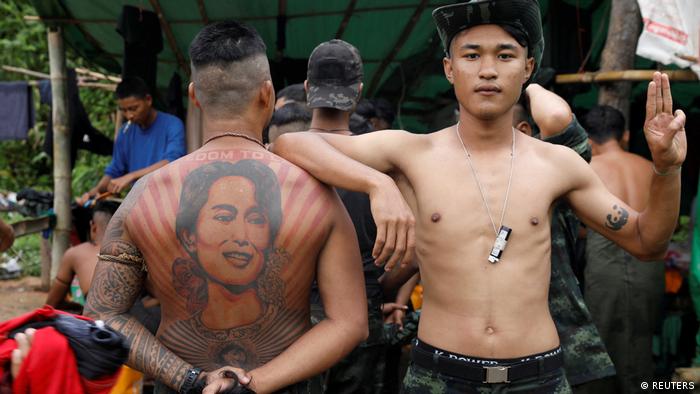
Myanmar People's Defence Force (PDF) fighters are still loosely organized
Who has the upper hand in Myanmar's civil war? Is it the military, which has been trying to control the country with brutal force since the coup, or the resistance movement, which is using guerrilla tactics against the military?
The question is being asked not only by people who are suffering, but also by leaders in neighboring countries and observers around the world.
Over the past six weeks, several reports, commentaries and interviews have appeared in English-language media and think tanks attempting an answer.
What are experts saying?
In an analysis published in the the Asia Times, "Is Myanmar's military starting to lose the war?" military and security expert Anthony Davis said that he believes the resistance movement is consolidating gains, after he initially thought directly after the coup that the situation would be hopeless.
Davis made similar comments in a subsequent interview with the Irrawaddy magazine.
Michael Martin, an analyst at the Center for Strategic and International Studies (CSIS) in Washington, recently wrote an analysis titled, "Is Myanmar's Military on Its Last Legs?"
Ye Myo Hein and Lucas Meyer published a commentary on the website "War on the Rocks," calling for a "more united, better-armed opposition" to bring "democracy to Myanmar."
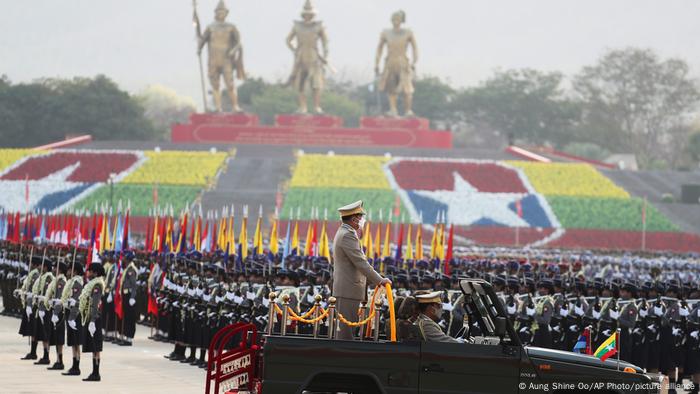
Junta chief Min Aung Hlaing during a military parade in March 2022
However, assessments of the conflict in Myanmar can differ widely, depending on what you read.
For example, The Economist reported in a recent article titled, "Myanmar's resistence is at risk of believing its own propaganda," that social media in Myanmar is spreading the "narrative of imminent victory" for the resistance movement.
However, according to the article, the facts on the ground speak a different language.
"Peer past the virtual fog, and a far bleaker picture emerges … Armed anti-regime groups are fragmented, with up to a dozen in a single district. A paucity of weapons has left them unable to go beyond guerrilla ambushes and assassinations," it reads.
At the other end of the spectrum is Michael Martin's commentary for CSIS. He writes: "There are growing signs that Myanmar's military is in a serious struggle to survive."
Most analyses fall somewhere in between these poles. However, except for the Economist, many of the reports assume that the situation has shifted in favor of the resistance in recent months. The question is, by how far?
Different numbers
Looking at the details, it becomes clear that the assessment of the overall situation is not the only place where there are divergences.
Data on the number of fighters and weapons also changes from analysis to analysis. It also depends on how "weapons" are defined.
For example, the article by "War on the Rocks" states that the armed resistance groups known as "People's Defense Forces" (PDF) have recruited about 100,000 fighters, 40% of whom are armed in some way with conventional and non-conventional arms, including homemade, or improvised weapons.
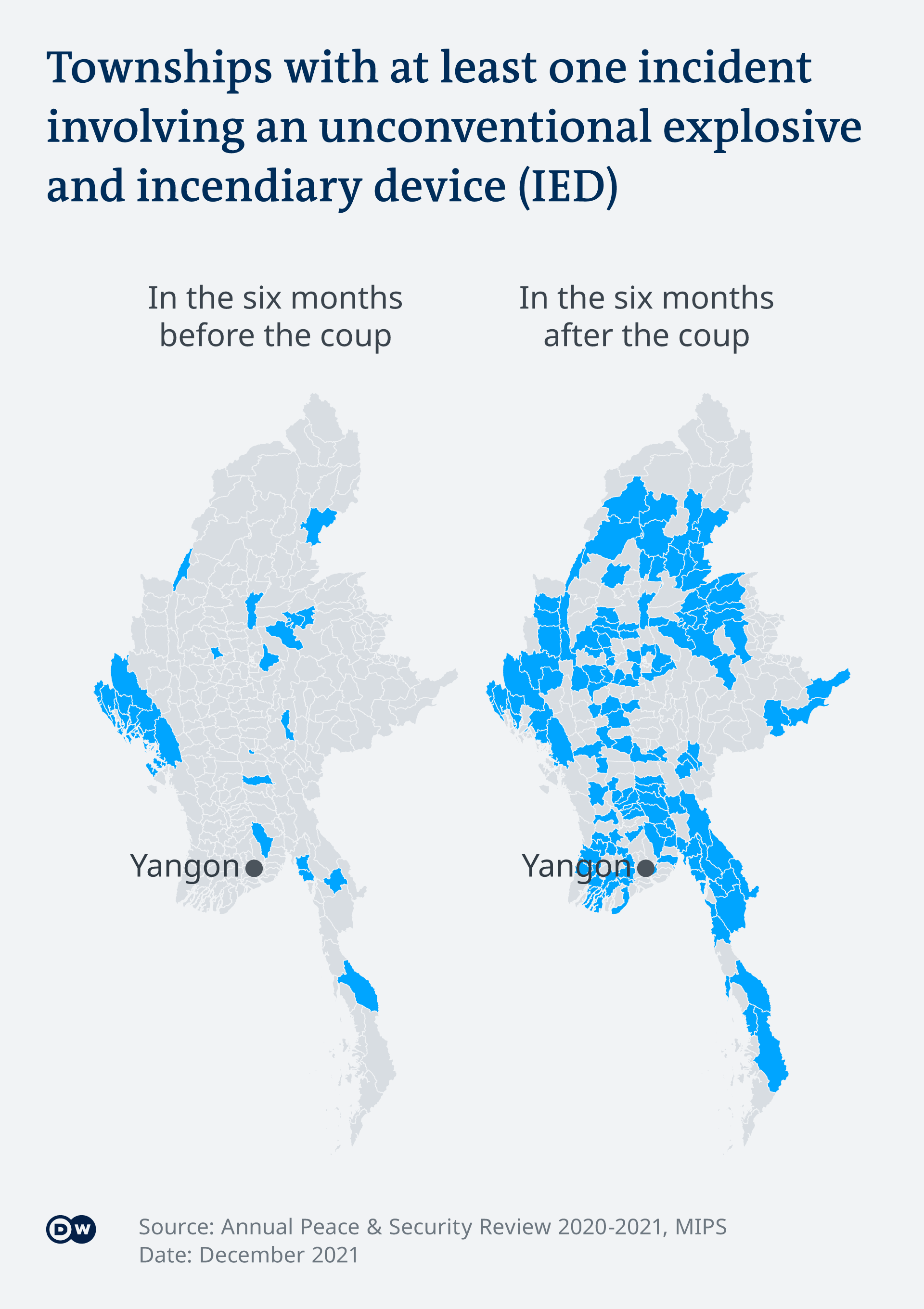
However, Davis, in his interview with The Irrawaddy, speaks of 50,000 to 100,000 fighters, and cites the National Unity Government's (NUG) ministry of defense as his source. Davis' analysis has less than 20% PDFs being armed, albeit limiting his scope to more conventional arms.
It's worth remembering that the NUG comprises the largely exiled government countering the military that claims to represent Myanmar politically. The NUG is also party to the conflict and its statements cannot be independently verified.
The NUG cannot quantify exactly how many members the resistance has, in part because there is no established chain of command from NUG to the PDFs, which operate more or less autonomously.
Min Zaw Oo from the Myanmar Institute for Peace and Security (MIPS) told DW he estimates that only 10% of PDFs are armed with automatic weapons.
He said these figures are based on reports of weapons seized or found after battles.
More serious than a lack of weapons, however, is the evident lack of ammunition among PDFs, which can be deduced from the fact that skirmishes with the military generally do not last longer than an hour.
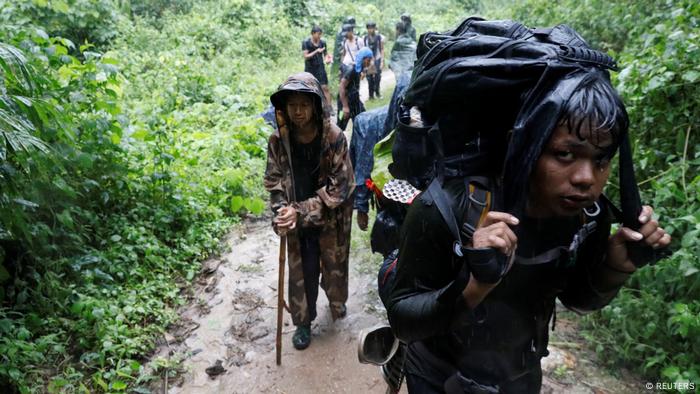
There are varying assessments on how well equipped PDF fighters are
Biased reporting?
Most articles covering the conflict in Myanmar specifically address the problems of unreliable data.
Davis said in the Asia Times that "coherent analysis is complicated by the sheer frequency and spread of small-unit clashes and attacks across a vast swath of the country, and by a striking lack of impartial news reporting from the frontlines of a civil war largely shielded from the outside world."
Local journalist Cape Diamond said that the media in Myanmar do not "deliver the entire picture" and often "understate defeats" of the PDFs.
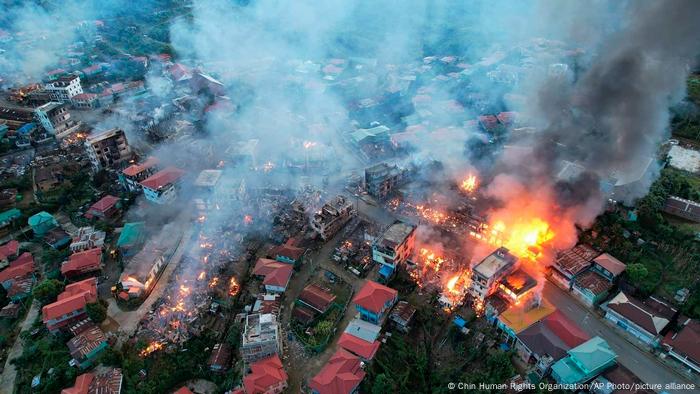
A village on fire in Myanmar's northwestern Chin state after government shelling
Breaking through the fog of war
The uncertainty in covering the civil war in Myanmar cannot be overemphasized. There is a lack of reliable information collected nationwide about the current situation in the country. There are individual reports, mostly of localized events, that are difficult to verify independently.
Min Zaw Oo is therefore skeptical about assessments of the overall situation or even an outcome of the conflict. "Different regions need to be assessed differently," he said.
The International Institute for Strategic Studies, which has created an interactive map of the current conflict, makes a similar argument.
"Rather than seeking to determine whether SAC or anti-SAC forces are 'winning,' the map emphasizes that the coup has altered long-standing power struggles by introducing new actors and alliances, with uneven effects across the country."
The only thing that can be said with certainty is that the violence has only spread and intensified since the coup.
However, the question of which side will win the civil war in the future remains open.
YE MYO HEIN AND LUCAS MYERS
JUNE 23, 2022
COMMENTARY

Myanmar’s rocky democratic transition ended abruptly in a military coup on February 1, 2021. Yet, the generals have kicked a hornet’s nest. The country’s Bamar majority has long dominated Myanmar, but an assortment of over 20 ethnic armed organizations have contested this situation for decades, and some have taken up arms once more to oppose the coup. Most crucially, faced with junta gunfire, the largely Bamar-dominated pro-democracy movement also made the grim decision to arm itself and fight the military.
The story of post-coup Myanmar is now one of a dedicated popular democratic resistance gaining momentum against a powerful military machine armed with Chinese and Russian equipment. This resistance is largely led by the predominantly Bamar National Unity Government in a loose coalition with some ethnic armed groups, ousted parliamentarians, and activists. They have shaken the junta to its core, successfully seized rural areas across the country, and enjoined several of the country’s ethnic armed groups to directly support them in the fight.
Yet, the odds against them remain steep. The National Unity Government lacks significant Western support — most notably in the form of arms — and still struggles to bring distrustful ethnic armed groups into a consolidated resistance movement. Currently operating as a diffuse and underequipped insurgency fighting what amounts to at least seven discrete conflicts, anti-junta forces lack strategic-level unity as well. While remarkably effective in numerous tactical skirmishes, the poorly equipped National Unity Government’s long-term prospects are, therefore, less than ideal. The junta’s military, known as the Sit-Tat, is suffering from overstretch and low morale, but still holds key cities and strategic locations with its superior airpower, armor, and artillery.
Nonetheless, the revolution can achieve victory. Resolving the fundamental distrust between the National Unity Government and ethnic armed organizations may be enough to overcome political and military roadblocks. This will require developing a shared political objective and an effective “coalitional” military strategy. It will also require persuading non-aligned ethnic armies as well as the Chinese government to increase the flow of arms, so anti-junta forces can launch coordinated offensives to take and hold territory. These steps could prompt the Sit-Tat’s collapse, or at least compel the junta to allow a return to democratic rule.
The Current Situation
Over the past few months, the National Unity Government’s military momentum has slowed as the junta deployed its air power and heavy weapons, locking down cities and preventing the rebels from consolidating their gains. In places like Mindat, Chin State, and Lay Kay Kaw, Karen State, the junta’s troops ousted poorly equipped People’s Defense Forces. In classic “authoritarian counterinsurgency” fashion, the junta continues to use unanswered firepower to displace lightly equipped units with little concern for escalating civilian casualties.
People’s Defense Forces and newly founded autonomous defense forces were successful in recruiting roughly 100,000 personnel, but only about 40 percent of them have any small arms whatsoever. Many of these weapons are rudimentary, either locally produced, cast off by the junta, or obtained on the black market from China and Thailand. Stealing weapons is not viable at scale. And while Chinese-supported ethnic armed groups have weapons like FN-6 man-portable air-defense systems that could dent the junta’s air and armor, they are reluctant to share them.
Politically, the incredibly diverse ethnic landscape in Myanmar has provided the National Unity Government with a number of potential armed allies, but it has also hampered anti-junta unity. Many ethnic groups have historical grievances and legitimate concerns with a Bamar-dominated pro-democracy movement, which results in limited cooperation beyond the tactical and operational levels. Some groups, such as the powerful United Wa State Army, seek to preserve their own interests regardless of the wider movement’s fate — especially if the National Unity Government’s odds of victory remain low.
Yet despite its problems, the National Unity Government and the wider pro-democracy movement cannot easily be crushed and show little intention of surrender. The junta has failed to cow the populace into submission, retake rural areas, or persuade the ethnic armies to join its side. While Myanmar has experienced numerous unsuccessful anti-government conflicts, and the Sit-Tat is often described as a formidable force, this time is different. As shown most recently during its 2019-20 fighting with the Arakan Army, the junta has struggled to defeat popular insurgencies. In the current round of conflict, the Sit-Tat has not only failed to prevail, in several places it cannot venture out into rural areas without suffering serious losses due to small-unit tactical failures. Moreover, the Bamar majority is now actively challenging the junta in a manner unseen since the 1980s, and fighting has spread throughout the country.
This leaves the Sit-Tat overstretched, overburdened, and short on morale. A total military victory for the pro-democracy forces led by the National Unity Government will still be difficult to achieve, but it is likelier now than it has been in decades. To date, the junta has made clear that it will not negotiate with the National Unity Government. Thus, while military victory is a long shot, the pro-democracy movement has no other option but to ramp up military pressure to either overthrow the junta or compel it to hand power to a civilian government.
The Need for Unity
Despite conducting a series of negotiations, the Bamar-dominated National Unity Government is struggling to find common ground with the ethnic armed organizations to build a mutually acceptable democratic federal state. Some dominant pro-democracy political entities still hold the dismissive views of ethnic actors that marked the National League for Democracy’s rule after 2015. Meanwhile, many ethnic armed groups pursue their own parochial interests. In addition to a few smaller outfits, the most powerful ethnic armed organizations on the National Unity Government’s side are the Kachin Independence Army in the north and the Karen National Union to the east. Both have supported the resistance movement since its inception and frequently launch offensives within their own territories, but they are hesitant to invest scarce resources in battlefields beyond their control.
Beyond the ethnic armed groups, only about 60 percent of the People’s Defense Forces and smaller Local Defense Forces are actually under the National Unity Government’s direct operational command. Moreover, the long hoped-for “federal army” capable of uniting the disparate ethnic armies and the People’s Defense Forces remains out of reach. While many of the ethnic armed groups reject peace talks with the military, they appear reluctant to wholeheartedly back the pro-democracy forces and some are open to junta outreach. This essentially splits the conflict into seven separate theaters with little overlap. It also allows the junta to “divide and conquer” and concentrate mass against isolated resistance pockets, as they have successfully done throughout their history.
The National Unity Government’s People’s Defense Forces have rapidly and effectively established themselves in the form of a cellular, horizontally networked guerilla force. Now the groups aiming to overthrow the junta need to undergo a sequential transition from a loosely organized movement to a more structured and centralized force. Martin C. Libicki and Ben Connable claim that networked armed movements “have lost significantly more often than they have won,” while hierarchically organized insurgencies have a better record. As Régis Debray, an associate of Che Guevara, claimed: “The lack of a single command puts the revolutionary forces in the situation of an artillery gunner who has not been told in which direction to fire.” Centralized command and control is necessary to field a force capable of taking urban settlements and strategic hard points.
Thus, the National Unity Government needs to consolidate its own chain of command and convince the fiercely independent ethnic armed organizations to accept a shared military strategy. It has attempted to do so through the establishment of a Central Command and Coordination Committee, but the ethnic armed groups have been loath to subordinate themselves to National Unity Government control. To overcome this, the National Unity Government will need to form a coalition around mutual goals in order to reach a consensus on an overarching strategy. This means forging a shared political objective before effective strategic military cooperation can occur.
Currently, the National Unity Government’s goal is to seize the central state apparatus, while the ethnic armed groups largely aim to consolidate their own autonomy. Persuading the ethnic armed organizations that it is in their interest to overthrow the Sit-Tat will require real inclusion and commitments to giving up some central authority in a federal democratic future. It would also be a real departure from Aung San Suu Kyi’s practices and likely would require moving beyond her legacy to build a more inclusive one. Any political arrangement must be conducive to genuine cooperation between the pro-democratic political forces and the ethnic armed groups. Most importantly, the National Unity Government must make the case to the ethnic armed organizations that the autonomy they seek can only happen under a democratic federal structure.
To be sure, the pro-democracy resistance movement has taken the right steps to advance this unity. It has created a National Unity Consultative Council, which could be a genuine political platform bringing together the country’s diverse stakeholders. Likewise, the Central Command and Coordinating Committee could create a military command structure that would improve collaboration. If the National Unity Government can demonstrate its practical cooperation with the ethnic armed groups, and the National Unity Consultative Council forges a strong alliance around a federal democratic future, they would be a strong magnet for uncommitted ethnic armies. This would also undermine the junta’s own efforts to co-opt ethnic armed groups. Just recently, the National Unity Government met with the currently uncommitted Arakan Army of Rakhine State in a move that is sure to turn heads in Naypyidaw.
If and once the National Unity Government persuades the ethnic armies to buy into a shared political objective, it can formulate a more effective military strategy and launch operations to take further territory. Based on her study of recent U.S. coalitions, Patricia A. Weitsman argues that “even in the absence of a unified chain of command, effective staff integration” is possible. Considering the reluctance of ethnic armed groups to embrace a “federal army” or fully cooperate with the National Unity Government, pro-democracy forces should at least work on shoring up the Central Command and Coordinating Committee and integrating high-level officers from its constituent coalition members within both itself and aligned ethnic armed organizations to formulate strategy and conduct operations across all seven theaters in Myanmar. This does not necessarily require subordination, but rather compromises and a shared understanding of national-level strategy. Without this, the movement will remain susceptible to the junta’s efforts to divide and conquer it.
Tackling the Military Problem
The other problem facing the National Unity Government is its ongoing lack of arms and equipment. The problem is particularly acute for People’s Defense Forces located outside territory held by ethnic armed organizations, or in regions such as Sagaing and Magway that are distant from Myanmar’s porous borders. In the early days of the conflict, homemade rifles and ancestral hunting weapons were enough to drive back the junta’s demoralized troops. But now, with the Sit-Tat’s forces supported by air power, modern small arms, light armored vehicles, and artillery, the sheer firepower brought to bear on the People’s Defense Forces is causing them to scatter to avoid direct confrontations. Thus, while they have no lack of enthusiastic recruits, they have been unable to move beyond rural guerilla tactics. The ethnic armies, with their better equipment and more reliable access to arms have performed somewhat better against junta offensives. For example, the Kachin Independence Army took the strategic Alaw Bum hill soon after widespread fighting broke out in early 2021, and has held the area against ferocious efforts to retake it with air power and artillery.
Once greater political unity is established, the People’s Defense Forces’ lack of equipment can be mitigated somewhat through cooperation with ethnic armed groups. Many of the ethnic armies, especially those along the Chinese border or aligned with the United Wa State Army, receive Chinese weapons and equipment, including anti-air systems. Other ethnic armies take advantage of longstanding ties to smugglers in Thailand and China to obtain black market weapons or have significant arms-making industrial capacity of their own. However, persuading the China-backed ethnic armies to sell more weapons directly to the pro-democracy resistance likely means getting Beijing on board as well. Given China’s growing support of the junta, this is no easy task. Yet, China is not the completely unitary actor that it is sometimes assumed to be, and Beijing also has a history of hedging in Myanmar. If the National Unity Government can win over the ethnic armed groups, demonstrate its capacity to govern territory, and, crucially, avoid angering China, then a pragmatic Beijing or local officials in China’s bordering Yunnan Province could acquiesce to a livelier arms trade. Given Western reticence towards arming the People’s Defense Forces, this may be their only option.
The End of the War?
The pro-democracy movement’s political and military problems may be pressing, but they are not insurmountable. The National Unity Government can rest assured of its main strengths: public support, strong commitment from allied ethnic armies, and quiet cooperation from the unaligned ethnic armed organizations. From this base, it should first unite the collective efforts of all anti-junta forces in pursuit of a genuine federal democracy, then craft a joint military strategy. In newly liberated regions, the National Unity Government and ethnic armed organizations should collaborate to establish effective parallel governance mechanisms to raise funds, ensure humanitarian aid and deliver stability. This will demonstrate to the international community that the pro-democracy movement is the people’s government that it claims to be. From there, military victory or the return of civilian rule may be possible.
Ye Myo Hein is the executive director of the Tagaung Institute of Political Studies and a public policy fellow with the Wilson Center. His research interests include civil-military relations in Myanmar, the country’s armed conflict, and its politics. The views expressed are the author’s alone, and do not represent the views of the U.S. Government or the Wilson Center.
Lucas Myers is a program coordinator and associate for Southeast Asia at the Wilson Center. His work focuses on Southeast Asian geopolitics, Chinese foreign policy, and Indo-Pacific security issues. The views expressed are the author’s alone, and do not represent the views of the U.S. Government or the Wilson Center.
Image: Karen National Union
No comments:
Post a Comment